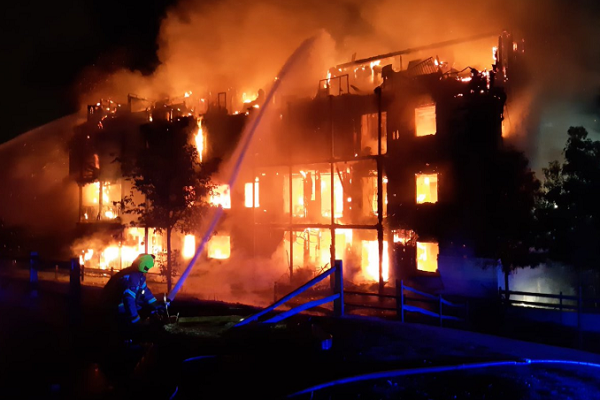How the temporary accommodation crisis is biting
The number of homeless families being housed in temporary accommodation is rising. An Inside Housing survey with Together casts more light on how this is playing out across the country

In association with:
![]()
Social landlords have warned that the sector urgently needs to build and buy more stock to address the temporary accommodation crisis. In a bid to understand the challenges, as well as how best to address the crisis, Inside Housing ran a survey in partnership with social housing finance provider, Together. A total of 110 respondents from councils and housing associations across the UK answered the survey, with 46% saying more stock was required to ease the crisis. A further 25% said “longer-term lease and rental solutions” would help, while 16% said the sector needed to “buy back more stock”.
The findings come as latest government figures in November 2023 showed a rise of 10.5% in households living in temporary accommodation in England to 105,750, including nearly 140,000 children.
Lack of availability
Survey responses came from senior staff, managers and directors working largely in departments linked to homelessness and housing management.
“Due to the lack of affordable and available housing in the social and private sectors, we are warehousing people for longer periods in temporary accommodation,” one respondent revealed. “As a result, the availability of this accommodation has significantly decreased.”
Another survey respondent echoed this, while laying out some key challenges to delivery. “Low-cost affordable temporary accommodation, which doesn’t have a significant subsidy loss [is needed, and] more long-term housing options, but our [Housing Revenue Account] has insufficient monies to build or buy more, due to all the changes with the [Social Housing (Regulation) Act] and increased fire safety works costs.”
More prevention work to tackle homelessness was flagged by respondents as another way to address the issue, as well as reviewing private sector rent levels.
“Temporary accommodation is at record numbers, with the vast majority sourced by third-party providers. These providers have informed [us] that there is no more availability, leaving us scrambling for properties, while competing with neighbouring authorities for the same small pool of properties,” said another respondent.
56%
Respondents who said ‘availability of stock’ was their top concern in responding to temporary accommodation
24%
Respondents who named ‘how to fund it’ as their top concern
53%
Respondents who said the Right to Buy had ‘considerably’ reduced stock
46%
Respondents who said more stock was needed to ease crisis
A significant 53% of respondents said the Right to Buy (RTB) scheme – which was introduced in the 1980s to enable eligible council tenants in England to buy their home at a discounted rate – had “considerably” reduced stock and therefore increased the pressure on temporary accommodation.
One respondent said the crisis was “a direct cause of RTB, leading to the reduction of the social housing sector, coupled with the severe cuts in housing budgets, especially in homelessness”.
Another respondent said they had lost over 5,000 social rented units in their borough, with most of these being family homes. Another said it was “a good policy in practice if governments had replaced housing stock”.
One respondent said: “The RTB legislation, in combination with successive governments’ obsession with low-cost homeownership products rather than low-cost rent, has created this crisis over the course of the last 40 years. We now have over 7,200 households on our waiting lists, and nearly 50 families in long-term B&B accommodation because of a lack of available social rented homes in the borough.”
The survey results come as the Local Government Association called for a revamp of the Right to Buy. The organisation said that for the last financial year, 10,896 homes were sold through the Right to Buy in England, while only 3,447 were replaced. This resulted in a net loss of 7,449 social homes in 2022-23 alone.
Asked what their top concern was in regard to responding to temporary accommodation in the next 12 months, more than half chose “the availability of stock”. “How to fund it” was selected by 24%.
On the sector’s concerns around funding, Alex Bodie, director of community housing and healthcare at Together, said having the right lender was key to helping social housing providers deliver more homes.
“This data shows there is clearly a problem, but what’s most worrying is the fact that this crisis is going to get significantly worse,” he says. “There are numerous reasons why this is happening, but there is a clear need for a long-term solution, not short-term fixes, which ultimately only add to the problem. As a lender, we can play our part in this solution by providing much-needed funding to landlords and local authorities, supported by a clear understanding of the sector and its issues.”
Funding cuts
Further comments from respondents painted a stark picture. “Our funding has been cut to the quick. Every department is struggling,” said one. Another added: “We have no money. We have a budget deficit of nearly [£2m] at a time where we need to spend huge sums on temporary accommodation. The sums don’t add up and I have no idea what we will do.”
Others offered insight into the challenges facing their boroughs. “I believe the cost of unsupported temporary accommodation is excessive and is causing considerable strain on the local government’s finances,” began one.
Another said: “Since the pandemic, the use of B&Bs has increased, plus the government’s ‘leave to remain’ policy, where people granted leave to remain have to leave [asylum seeker accommodation] within seven days instead of 28 days, doesn’t allow people to get their benefits in place before they become homeless, adding extra strain on already stretched homeless services.”
One called on the sector to develop a clearer strategy around dealing with temporary accommodation, while being open to “innovation and partnerships”.
Northern Ireland has also seen a huge increase in people in temporary accommodation, rising 104% in four years, to 4,200 households by July 2023, the last period for which data is available. One respondent in Northern Ireland said cuts to Supporting People funding, which is spent on supported housing projects, are exacerbating things and adding to the pressure.
“There are limited offers for those in hostel and temporary accommodation, which is basically ‘bed blocking’, which is increasing pressure to accommodate people into non-standard [accommodation], such as B&B and hotel accommodation.”
Summing up the issue, one respondent said: “Two-thirds of the temporary accommodation stock [in our borough] is due to be demolished for development. This comes at a time when there is increasing demand for emergency and temporary accommodation. Emergency accommodation providers that have worked with the council for 20-plus years are moving out of the market.
“There is increased pressure from no-fault evictions, the PRS is contracting and the available properties are unaffordable for many. [There is also an] inadequate supply of affordable housing to [home] people moving on from temporary accommodation, and limited options for large families and adapted properties.”










